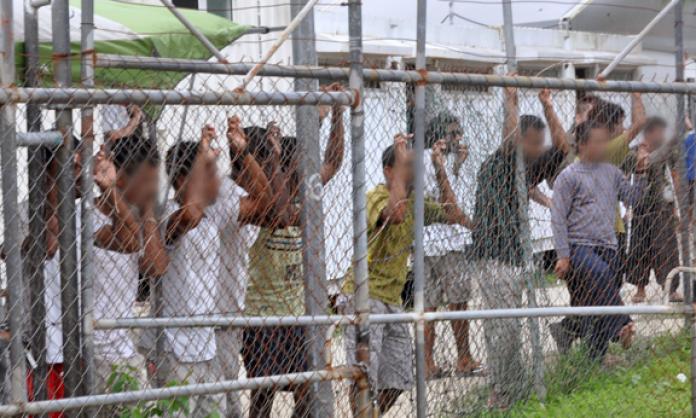The acrimony over Australia’s “refugee deal” with the United States has created an unprecedented sense of diplomatic turmoil between the two counties. But the situation only underlines the Australian government’s appalling treatment of asylum seekers.
The only country responsible for the refugees on Manus Island and Nauru is Australia, and it’s Australian prime minister Malcolm Turnbull whose inhumanity has been on stark display throughout this whole “dilemma”.
While politicians bicker and blush from the comfort of their lavish offices, thousands of men, women and children continue to languish in island prison camps, their suffering prolonged as the political games continue.
The horrors in these gulags almost defy description. The most recent example is a teenager’s attempted suicide on 29 January. A few days earlier, a pregnant Kuwaiti woman with a tumour in her uterus was denied a medical evacuation. A major outcry led to her now being brought to Australia for treatment, but at the time of writing her conditions are life-threatening. On New Year’s Eve, two men were brutally bashed by the police on Manus island. On Christmas Eve, 27-year-old Sudanese man Faysal Ishak Ahmed died. He had spent months in agony, his pleas to see a doctor ignored.
These are just the latest atrocities in a system of murder and abuse, which is descending into absolute crisis. The refugees continue to declare their own humanity against these horrors, recording more than 200 days of protest on Nauru in the last year. After the death of Faysal, detainees rioted on Manus, turfing out the guards and taking control of the compounds. “This system is designed to kill us, one by one”, 24-year-old Abdul Aziz Adam told ABC News.
The government has been silent, hoping that the deal with US would end its troubles. “End”, of course, means pushing the refugees out of sight, perhaps into Trump’s “extreme vetting” process, or perhaps back to the war and persecution they fled from, out of fear of what the US megalomaniac might do to them.
The solution to this nightmare is simple: bring the refugees here now, without any delays, and give them the assistance they need to begin their lives and overcome the abuses they’ve been subjected to. It is beyond obscene that they have been forced to endure such conditions at all, let alone for months and months, years and years, and indefinitely into an unknown future. A shred of decency is all that’s needed to end this.
For the Australian government, this is too much to ask. Turnbull’s reactions to Trump’s executive actions on immigration are evidence enough of this. “If others wish to emulate what we’re doing, they’re welcome to do so”, was the response to Trump’s announcement that he would ban immigration from seven Muslim- majority countries and begin the construction of a wall along the Mexican border.
As protesters massed throughout the United States and the rest of the world, calling for defiance and solidarity in the face of Trump’s racist onslaught, minister after minister from the Australian government lined up to express not only their faith, but their outright pride, in president Trump.
There was Peter Dutton, who backed Trump’s “sovereign right” to ban asylum seekers; Julie Bishop, who spruiked Trump’s “strong immigration and border protection policies”; and Scott Morrison, who gloated that “the rest of the world is catching up to Australia” when it comes to bashing refugees.
History of torture
Gluttons for racism and the suffering of others that they are, our politicians’ grotesquely misplaced pride rings true. For more than a decade, Australian governments have been trailblazers in the art and science of asylum seeker abuse. And from the early days of the “war on terror”, to Tony Abbott’s “Team Australia”, to the re-entrance of Pauline Hanson into federal politics, Australian politicians have set a global standard in transforming vulnerable people into political footballs.
It began with the Labor Party and the introduction of mandatory detention in 1992, but it was under the conservative Howard government in the early 2000s that refugee bashing took centre stage. Backed by a vicious mainstream press and facing a spineless opposition, Howard attempted to improve his poor polling by blocking a Norwegian freighter ship, the Tampa, which had rescued drowning refugees, from receiving harbour in Australia.
Forcing the Tampa to reroute to New Zealand, Howard declared: “We will decide who comes to this country and the circumstances in which they come”. What followed has been an era of extreme xenophobia and fearmongering in Australian politics, in which the Labor Party has proven a willing accomplice.
This has not been confined to rhetoric. After turning back the Tampa, Howard moved quickly to make Australia’s borders some of the most militarised in the world. The government began sending the navy to intercept boats and forced refugees into island detention camps out of sight of the mainland. Over time, the gunships were shadowed by aerial drones, and complex intelligence networks were designed to push boats back. Distressed vessels were ignored as refugees drowned at sea, and the Australian Federal Police paid to have boats scuttled in Indonesia.
For those who made it through, barbed wire and brutal abuse waited. Private security contractors administered detention centres by abusing their inhabitants with impunity. The Nauru Files, released last year, found more than 2,000 cases of abuse in three years, a majority of which were of children. Even this was but a glimpse into the atrocities.
The terror and trauma that Trump threatens to unleash have long resounded through the walls of Australia’s detention centres.
Foreshadowing Trump in another regard, the Australian government has trashed international law and human rights conventions every step of the way. Every pillar of Australia’s asylum policy – imprisoning refugees, depriving them of legal counsel, turning back boats – violates the UN Convention on the Rights of Refugees. For Australian leaders this has been a point of pride. “Too much mercy for some necessarily undermines justice for all”, Tony Abbott remarked to a gathering of British conservatives in 2015. To all intents and purposes, this was indistinguishable from Trump’s advocacy of torture.
Fascist applause
For many, this has made Australia’s asylum policy a source of national shame, comparable to the Stolen Generations or apartheid. In certain circles, however, mere mention of the words “Australia” and “refugees” will set a twinkle in the eye.
“Heroic” was the term ultra-racist Nigel Farage used to greet Abbott on the occasion of his British visit. For journalist Katie Hopkins, who called drowned refugees “cockroaches”, Australia is hallowed ground, with its “tiny hearts and whacking great gunships”. Hopkins wrote of the Australian government, “Their approach to migrant boats is the sort of approach we need in the Mediterranean”.
Nazi and fascist parties have been similarly laudatory. German fascists in the Pegida movement called Australia’s policies “the only real solution” to the European refugee crisis. In Greece, an MP for the Nazi group Golden Dawn said simply of Abbott, “He has been tough on illegal immigration and I support his position”.
And now the wheel has come full circle. Donald Trump, the darling of the alt-right and KKK, is cheered by Australian cabinet ministers as he sails through waters they charted long ago. With shameless hypocrisy, the Labor Party has attempted to stand apart, preening about diversity and “the fair go”. Yet it has been lockstep with the Liberals for almost all of the last 15 years, and no amount of suffering has taught it to do otherwise.
There is only one road forward to freedom and justice for refugees. Without resistance, the Trump era will be one of new horrors, and old ones born anew. As a new generation of activists in the United States shuts down airports and highways, it is time for us to tear apart fortress Australia, brick by blood-soaked brick.









